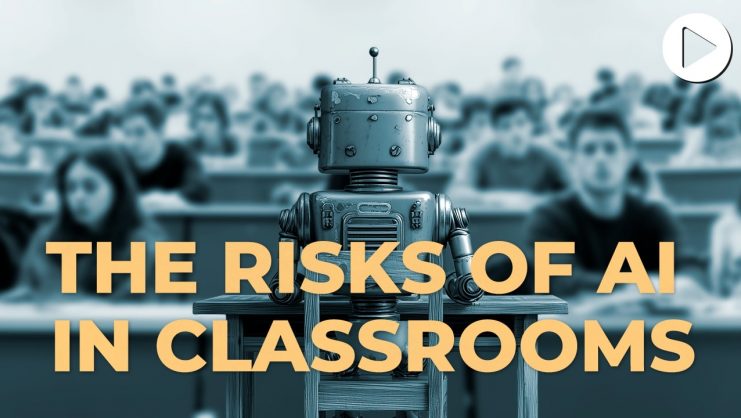Technology is transforming higher education and must be placed at its core. The COVID pandemic made clear the importance of digital strategies for reaching students. Education technologies, however, go far beyond online lessons – they play a significant role in how universities operate, teach, and engage with learners, ultimately boosting student employability.
With artificial intelligence, machine learning, the Internet of Things, augmented reality, and automation shaping the new world of work, traditional learning models that neglect digitalization are failing to address the labor needs of industry. According to Korn Ferry, these talent gaps could lead to about $8.5 trillion in lost revenues by 2030. Universities must therefore develop and incorporate digital strategies to stay relevant and prepare their students for the jobs of today and the future.
Consider AI, for instance. Even though the technology has existed since as far back as the middle of the 20th Century, its popularity and relevance have significantly grown as of late, particularly following the advent of ChatGPT. Today, AI is powering several aspects of the learning journey, including the automation of routine administrative tasks, faculty and student engagement, survey management, feedback collection, and administration of research. Similarly, augmented reality is redefining higher education by fostering immersive and interactive learning experiences that shape engagement between learners and their tutors. This includes supporting students in visualizing complex subjects and translating abstract ideas into relatable, everyday experiences.
On many levels, this digital shift presents exciting possibilities for higher education.
First, digitalization provides a foundation to address the global talent shortage. The Fourth Industrial Revolution is redefining the concept of skills, as traditional job roles give way to emerging paradigms. Today’s evolving labor landscape demands competencies that were largely unknown a decade ago.
The scale of this transformation is striking. Since 2015, the skill sets required for jobs have shifted by 25%, and this is expected to double by 2027, according to a report by LinkedIn that surveyed people in the Americas, Asia, and Europe. The World Economic Forum’s The Future of Jobs Report reinforces this trend, with employers predicting that 44% of workers’ skills will undergo significant changes or disruption within the next four years.
In many emerging markets, employers report that university graduates lack preparedness for the modern workplace. This exacerbates the global talent shortage, with around 75% of employers jostling to fill open roles globally, according to ManpowerGroup. Digitalization offers a path for universities and academic institutions to ensure their students are ready for the job market.
The ubiquitous digital culture of easy access, choice, and efficiency has shifted power into the hands of learners.
Secondly, digitalization fosters access to equal opportunity by enabling more young people to benefit from education. Notwithstanding the significant growth in access to higher education over the past two decades, economically vulnerable populations still face barriers. In Sub-Saharan Africa, for example, although demand for higher education grows by 15% annually, only nine percent of young people aged 18 to 23 are enrolled in a tertiary institution.
The story is similar in Latin America, where income inequality fuels educational disparities. In spite of the remarkable growth in gross enrollment rates in higher education, access remains concentrated among the region’s wealthier income brackets. According to a World Bank report, young people from the highest income quintiles are 45% more likely to access higher education than their counterparts from the poorest. Digitalization has the potential to level the playing field and expand access to flexible and affordable learning options – opportunities that do not exist within the traditional education setup.
Thirdly, digitalization can transform the student experience. Today’s students – like every consumer segment inundated by the options offered by technology – demand elevated experiences and enhanced engagement. The ubiquitous digital culture of easy access, choice, and efficiency has shifted power into the hands of learners. This presents both a threat and an opportunity to advance learning, with students looking for more than classroom learning technologies; they want integrated solutions that address their academic, wellbeing, and mentoring needs.
Leading universities are responding with innovative solutions. Some are using internal networking platforms and online forums to help students share perspectives on relevant academic topics and submit assignments. Unlike in the past, universities are also using student-focused health apps to support the general wellbeing and mental health of learners. These technologies provide students with access to a range of resources, including therapists, first aid support, and information about how to access medical assistance in emergency situations. In emerging markets, universities are leveraging tools like Vitae to improve students’ employability and transform their programs to better meet the needs of students. This helps in addressing the age-long disconnect between higher education and market needs.
The rise of AI adds urgency: universities with outdated technologies risk falling as far behind as those without any digital strategy at all. Simply put, institutions can no longer afford inaction.
In a study spanning more than 600 institutions, nearly 1,600 students, and 1,000 faculty members, 75% of students indicated they would continue to use Generative AI for their studies – even if the technology were prohibited by their institutions. This is the reality and digital transformation empowers universities to address these challenges proactively by creating an ethical environment that defines responsible AI use, establishes clear guidelines, and promotes compliance.
Despite the profound impact of digitalization on higher education, emerging markets risk lagging behind. The tripartite hurdle of infrastructure, cost, and policy impedes digital adoption in many developing countries. Around 2.6 billion people – about one-third of the global population – remain offline. Women in the least developed countries are among the hardest hit, with 70% lacking internet access. Poor policies fuel high digitalization costs and discourage private sector investment in emerging markets. The lean budgets of many universities in developing markets fall short of the financing required to embark on digital transformation projects. When juxtaposed with the poor policy environment in some institutions – where there are still complex procurement and partnership policies – digitalization is forced to take a back seat.
Meanwhile, some universities adopt a fragmented approach to digitalization. In such cases, their initiatives lack cohesion, focusing on standalone tools rather than putting people, culture, and technology at the center of the process. Digitalization becomes a one-off project instead of a long-term strategy. Limited resources mean compromising on the quality of technology.
Not surprisingly, digital transformation requires significant capital investment – from software costs to training, system integration, and maintenance. Regardless, it is counterproductive to let these costs overshadow the gains of digitalization.
Educational technologies can catalyze the development of young people ready to drive productivity and growth. Yet the prevailing funding models of many institutions make digitalization seem out of reach. Higher education leaders, technology providers, governments, the private sector, and development institutions must join forces to build solutions together.
Learning in an era of disruption can be complex, risking the exclusion of vulnerable populations – as the COVID pandemic demonstrated. Digital transformation offers the potential to enhance learning experiences, democratize access, and strengthen the global workforce.
The future belongs to universities that make the digital leap today.
© IE Insights.











